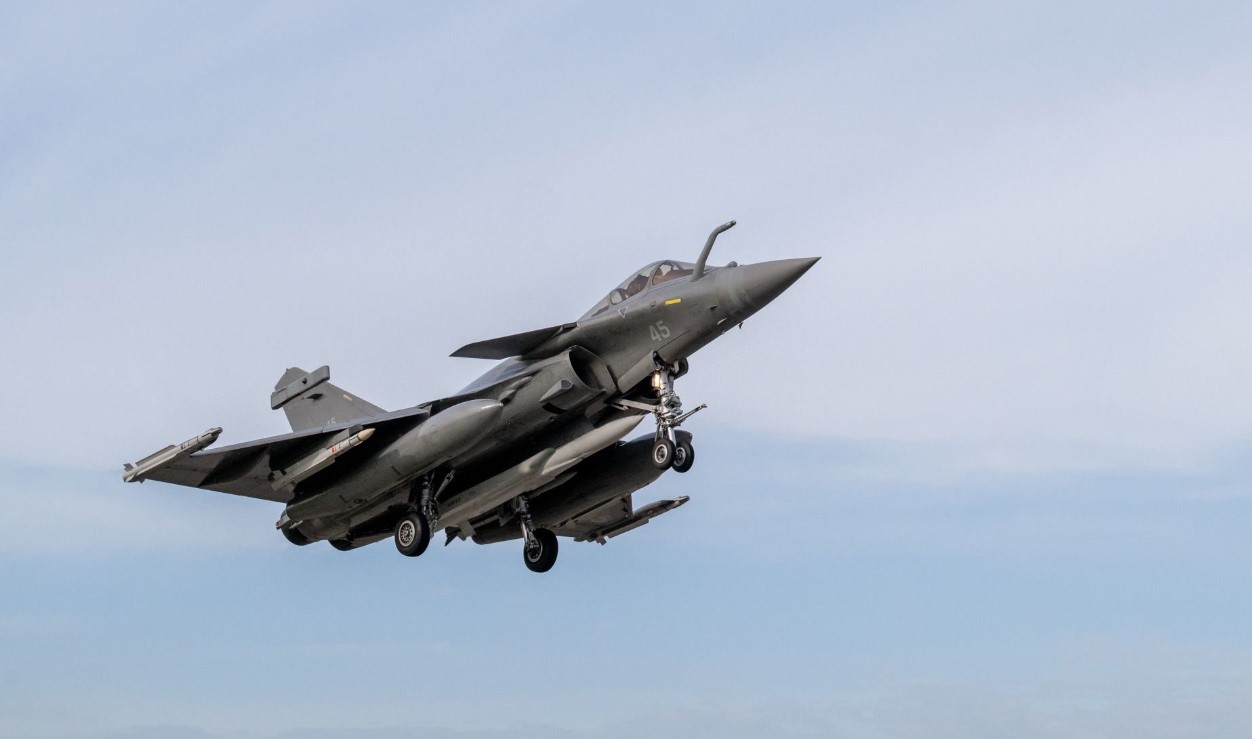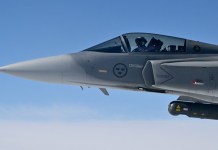For the first time, France has published images of its latest-generation nuclear-capable supersonic air-to-surface cruise missile, the Air-Sol Moyenne Portée-Renove (ASMPA-R), after an unarmed version of the missile was test-fired from the French Navy’s Dassault Rafale-M fighter jet, following the weapon’s formal entry into service.
A statement by the Ministry of the Armed Forces of France said, “An evaluation shot of the improved renovated medium-range air-to-surface strategic missile (ASMPA-R) was successfully carried out by the Nuclear Aeronaval Force (FANU).”
FANu is France’s Naval Nuclear Aviation Force, which refers to the French Navy’s nuclear-powered aircraft carrier strike group, Charles de Gaulle, and its embarked air wing of Rafale M fighter jets.
Notably, the missile has been in service with the French Forces Aériens Stratégiques (FAS), or Strategic Air Forces, part of the French Air and Space Force, since 2023.
Both the air and naval services use Rafale variants as launch platforms for these missiles.
In a social media post, Catherine Vautrin, France’s Minister of the Armed Forces, said: “This is the second firing of the ASMPA-R and the first carried out by the Nuclear Aeronaval Force (FANU). This firing takes place only a few days after the Operational Service Entry (OSE) of the ASMPA-R missile within the FANU. This missile has already been in service in the Strategic Air Forces (SAF) since 2023.”
Opération DIOMEDE : un Rafale Marine a conduit ce jour avec succès un tir d’évaluation du missile stratégique Air-sol moyenne portée amélioré rénové (ASMPA-R), sans charge embarquée, au terme d’un vol représentatif d’un raid nucléaire.
Il s’agit du second tir de l’ASMPA-R et du… pic.twitter.com/IhxBskEdNu
— Catherine Vautrin (@CaVautrin) November 13, 2025
The French Air Force test-fired the ASMPA-R from a Rafale fighter jet in 2023; however, in images released by the French Air Force, the missile was entirely obscured at the time. Another picture from the test launch was published, but it was so low quality that no discernible details of the weapon could be seen.
The Three-Decade-Long Journey Of ASMPA: From ASMPA To ASMPA-A To ASMPA-R
ASMPA-R is a liquid-fuel, ramjet-powered, nuclear-capable, medium-range air-to-surface missile, which is capable of reaching high supersonic speeds up to Mach 3. Before the main ignition, the missile is boosted by an internal solid-fuel cartridge to achieve the required launch speed.
The ASMPA-R, which is the second upgrade of the ASMPA cruise missile, has a range of 600 km (372 miles).
The earlier version ASMPA-A, which was already in service with the French Naval Forces, had a range of 500 km (310 miles). However, both versions can reach speeds up to Mach 3.

There is speculation about whether the ASMPA-R will also feature a new nuclear warhead. The earlier version, ASMPA-A, carried a TNA-design nuclear warhead with reported yield settings ranging from 100 to 300 kilotons.
The ASMPA-A started entering service in 2009.
Though the missile versions look similar on the outside, there are subtle differences between ASMPA-A and ASMPA-R. Both versions feature centrally located air intakes, part of the ramjet propulsion systems.
However, the tail fin designs are different. The A variant featured smaller fins at the rear and larger ones in the front; however, the R variant reverses this arrangement, with larger fins at the rear and smaller ones at the front.
The ASMPA-A was itself the upgraded version of ASMPA, which entered service in 1986. The ASMPA had a maximum range of 300 km (186 miles).

According to Missile Threat, a web portal detailing technical specifications of missiles, the missile was developed as a product of a competition between Matra’s turbojet proposal and Aerospatiale’s ramjet proposal (now MBDA).
The ramjet version was chosen, and full-scale development began in 1978. The goal was to replace the AN-22 nuclear bomb carried by the Mirage IV with a cruise missile that could penetrate air defenses and achieve a more credible deterrent vis-à-vis the Soviet Union.
In 1999, MBDA developed the ASMP-A (Améliorateur Plus) to increase the missile’s range and accuracy, as well as to modernize its systems. The first tests began in December 2000 and continued in 2001, 2006, and 2009. The missile became operational in October 2009.
The ASMP is 5.38 m in length, 0.38 m in body diameter, and has a launch weight of 860 kg. The earlier version of the missile carried the TN-80, a 300kT nuclear warhead with a 200 kg payload, while the later version carries both the TN-81 and the 300kT nuclear warheads, with a reduced payload of 180 kg.
Future Variant
France is also working on a future variant of ASMPA-R, the Air-Sol Nucléaire de 4ème Génération (ASN4G; or 4th-Generation Air-to-Surface Nuclear-armed cruise missile). The ASN4G will arm the next Rafale variant, the Rafale F5 fighter, and its carrier-based variant.
The ASN4G will also be ramjet-powered; however, it will be capable of reaching hypersonic speeds, which is defined as Mach 5 or more.
The ASN4G is scheduled to enter France’s arsenal by 2035.
France’s Nuclear Deterrent
The successful launch of ASMP-R will strengthen France’s nuclear dyad, comprising two delivery systems for its independent nuclear deterrent, known as the Force de Frappe.
Its sea-based component includes Triomphant-class nuclear-powered ballistic missile submarines (SSBNs).
Currently, France has four such submarines in service. They are equipped with M51 SLBMs (Submarine-Launched Ballistic Missiles) and have a range of 9,000 to 12,000 km.
The ASMPA series of air-to-surface missiles, which can be launched from land-based Rafale and carrier-based Rafale-M fighter jets, make up the aerial leg of France’s current nuclear dyad.
The supersonic speed and stand-off launch capabilities of the ASMPA series of missiles mean they can be launched from a safe distance and are difficult to intercept.
Their integration with Rafale-M means France can now also launch ASMPA-R from its Charles de Gaulle aircraft carrier, further strengthening its nuclear deterrence at a time of renewed openness about nuclear arms and their delivery platforms.
Last Month, US President Donald Trump said that Russia, China, and Pakistan are continuing with nuclear tests, and the US can also resume nuclear weapons testing.
Days later, the US also test-fired its nuclear-capable surface-to-surface missile, the Minuteman III .
The sentiment was also echoed by France’s Minister of the Armed Forces, Catherine Vautrin, in her social media post.
“Long planned, this successful operation fulfills the ambition set by the President of the Republic and completes the maneuver to renew the capabilities of the airborne nuclear component as planned by the Military Programming Law (2024-2030),” she said.
Earlier this year, French President Emmanuel Macron had said that France would like to establish a new nuclear air base and could also forward-deploy its nuclear-capable Rafales to Germany.
France is also entertaining the idea of using its nuclear weapons to provide a nuclear-protection umbrella for Europe to counter rising nuclear saber-rattling from Russia.
In such an atmosphere, the successful test launch of ASMPA-R from carrier-based Rafale-M will strengthen France’s nuclear deterrence.
- Sumit Ahlawat has over a decade of experience in news media. He has worked with Press Trust of India, Times Now, Zee News, Economic Times, and Microsoft News. He holds a Master’s Degree in International Media and Modern History from the University of Sheffield, UK.
- VIEWS PERSONAL OF THE AUTHOR.
- He can be reached at ahlawat.sumit85 (at) gmail.com




